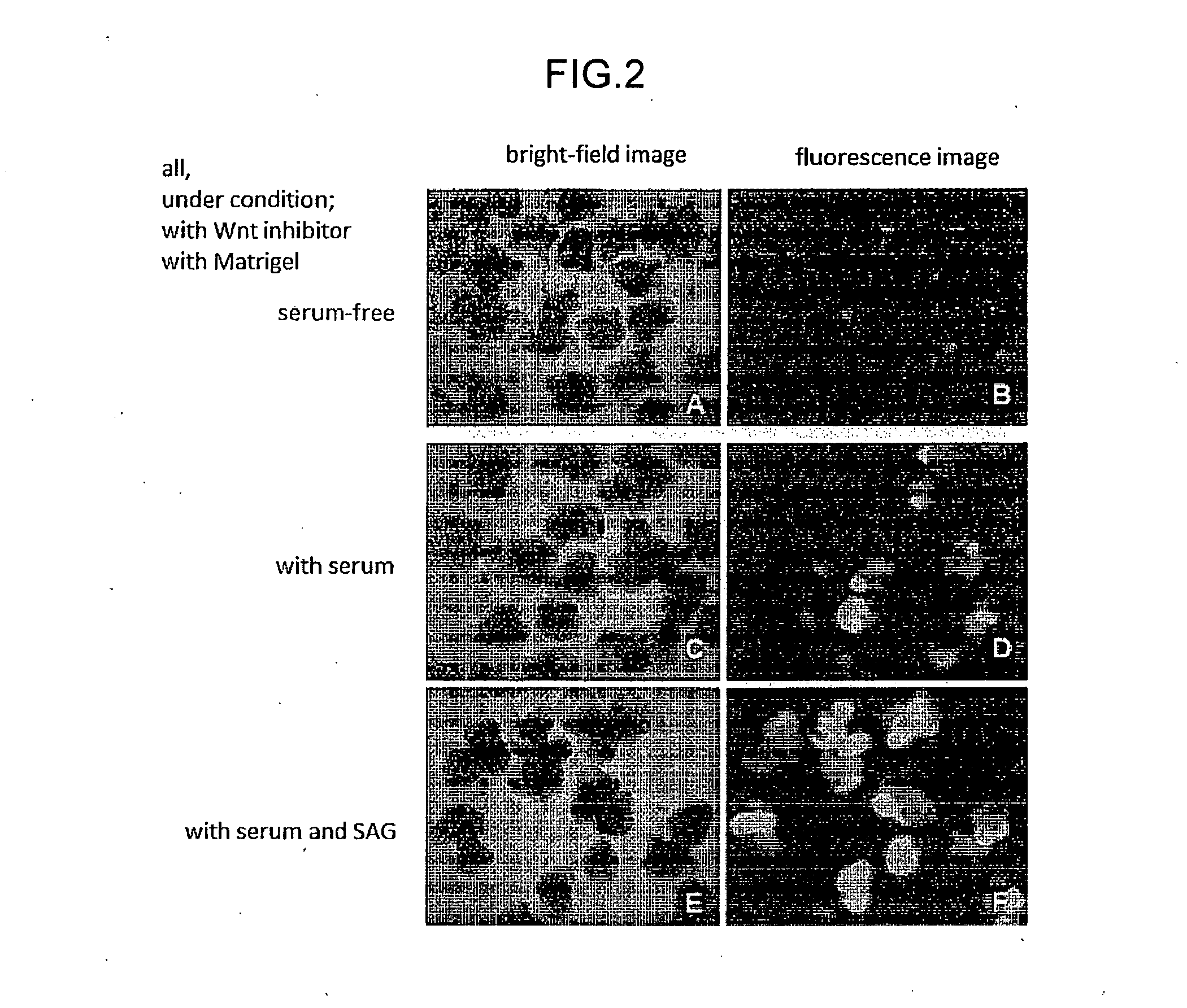Methods for producing retinal tissue and retina-related cell
a technology tissue, which is applied in the direction of biocide, instruments, prostheses, etc., can solve the problems of low regenerative capacity of central nervous system tissues such as the brain and retina, scarce spontaneous recovery of damaged tissues, and low efficiency of retinal pigment epithelia production, etc., to achieve high efficiency and high usefulness
- Summary
- Abstract
- Description
- Claims
- Application Information
AI Technical Summary
Benefits of technology
Problems solved by technology
Method used
Image
Examples
example 1
Production of Retinal Tissue by Using Human ES Cells (Wnt Signal Pathway Inhibitor and Matrigel, Serum Addition Conditions)
[0144]RAX::GFP knock-in human ES cells (derived from KhES-1) were cultured according to the methods described in “Deno, M. et al. PNAS 2006”, “Watanabe, K. et al. Nat Biotech 2007” and used for the experiment. As the medium, DMEM / F12 medium (Invitrogen) added with 20% KSR (Knockout Serum Replacement; Invitrogen), 0.1 mM 2-mercaptoethanol, 1 mM pyruvic acid, and 5 to 10 ng / ml bFGF was used. For the production of retinal tissue by floating culture, the ES cells were dispersed into single cells by using 0.25% trypsin-EDTA (Invitrogen), and floating-cultured in a serum-free medium (100 μl) at 37° C., 5% CO2 to 9×10̂3 cells per well of a non-cell adhesive 96-well culture plate (SUMILON spheroid plate, SUMITOMO BAKELITE CO., LTD.). As the serum-free medium in this case, a serum-free medium obtained by adding 20% KSR, 0.1 mM 2-mercaptoethanol, 1 mM pyruvic acid, 20 μM ...
example 2
Production of Retinal Tissue by Using Human ES Cells (Conditions with Addition of Wnt Signal Pathway Inhibitor and Matrigel, Serum and a Substance Acting on the Shh Signal)
[0146]RAX::GFP knock-in human ES cells (derived from KhES-1) were cultured according to the methods described in “Ueno, M. et al. PNAS 2006”, “Watanabe, K. et al. Nat Biotech 2007” and used for the experiment. As the medium, DMEM / F12 medium (Invitrogen) added with 20% KSR (Knockout Serum Replacement; Invitrogen), 0.1 mM 2-mercaptoethanol, 1 mM pyruvic acid, and 5 to 10 ng / ml bFGF was used. For the production of retinal tissue by floating culture, the ES cells were dispersed into single cells by using 0.25% trypsin-EDTA (Invitrogen), and floating-cultured in a serum-free medium (100 μl) at 37° C., 5% CO2 to 9×10̂3 cells per well of a non-cell adhesive 96-well culture plate (SUMILON spheroid plate, SUMITOMO BAKELITE CO., LTD.). As the serum-free medium in this case, a serum-free medium obtained by adding 20% KSR, 0....
example 3
Confirmation of Retinal Tissue Formation
(Method)
[0149]Formation of retinal tissue was confirmed with the aggregates having GFP-expressing cells, which were produced in Examples 2 and 3. Using a serum-containing medium obtained by adding N2 supplement, 10% (v / v) fetal calf serum and 0.5 μM retinoic acid to DMEM / F12 medium, floating culture was performed under the conditions of 40% O2 from day 18 from the start of the floating culture. Thereafter, the aggregated mass was fixed with 4% para-formaldehyde solution, a frozen section was prepared, and the tissue structure was confirmed by the immunostaining method.
[0150]As a result, it was revealed on day 60 from the start of the floating culture that Brn3 and TuJ1-positive ganglion cells in the lowermost layer, Crx and Recoverin-positive photoreceptor-precursor cells in the outermost layer and intermediate layer, and interneuron progenitor cells such as Chx10-positive bipolar cells between the Brn3-positive cells in the outermost layer an...
PUM
 Login to View More
Login to View More Abstract
Description
Claims
Application Information
 Login to View More
Login to View More - R&D
- Intellectual Property
- Life Sciences
- Materials
- Tech Scout
- Unparalleled Data Quality
- Higher Quality Content
- 60% Fewer Hallucinations
Browse by: Latest US Patents, China's latest patents, Technical Efficacy Thesaurus, Application Domain, Technology Topic, Popular Technical Reports.
© 2025 PatSnap. All rights reserved.Legal|Privacy policy|Modern Slavery Act Transparency Statement|Sitemap|About US| Contact US: help@patsnap.com



